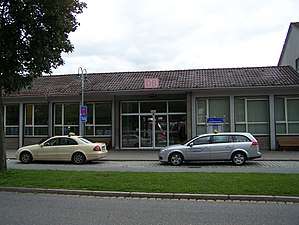Donaueschingen station
Donaueschingen station is a junction station in the south of the German state of Baden-Württemberg. It is the only official Bahnhof (station) in the city of Donaueschingen. The city also has the Haltepunkte (halts, which is defined in Germany as a station having no sets of points) of Donaueschingen Allmendshofen, Donaueschingen Mitte/Siedlung, Donaueschingen Aufen and Donaueschingen Grüningen. The station is classified by Deutsche Bahn (DB) as a category 4 station and has five platform tracks. It is used daily by about 100 trains operated by DB long-distance, DB Regio and the Hohenzollerische Landesbahn.
| Through station | |||||||||||||||||||||||||||||||
 | |||||||||||||||||||||||||||||||
| Location | Bahnhofstr. 1 Donaueschingen, Baden-Württemberg Germany | ||||||||||||||||||||||||||||||
| Coordinates | 47°56′52″N 8°29′56″E | ||||||||||||||||||||||||||||||
| Elevation | 677 m (2,221 ft) | ||||||||||||||||||||||||||||||
| Owned by | DB Netz | ||||||||||||||||||||||||||||||
| Operated by | DB Station&Service | ||||||||||||||||||||||||||||||
| Line(s) |
| ||||||||||||||||||||||||||||||
| Platforms | 5 | ||||||||||||||||||||||||||||||
| Other information | |||||||||||||||||||||||||||||||
| Station code | 1264[1] | ||||||||||||||||||||||||||||||
| DS100 code | RDO[2] | ||||||||||||||||||||||||||||||
| IBNR | 8000077 | ||||||||||||||||||||||||||||||
| Category | 4[1] | ||||||||||||||||||||||||||||||
| Website | www.bahnhof.de | ||||||||||||||||||||||||||||||
| History | |||||||||||||||||||||||||||||||
| Opened | 15 June 1868 | ||||||||||||||||||||||||||||||
| Services | |||||||||||||||||||||||||||||||
| |||||||||||||||||||||||||||||||
| Location | |||||||||||||||||||||||||||||||
 Donaueschingen Location in Baden-Württemberg  Donaueschingen Location in Germany  Donaueschingen Location in Europe | |||||||||||||||||||||||||||||||
History
The station was opened on 15 June 1868 with the completion of the Black Forest Railway from Donaueschingen to Immendingen. On 6 August 1869, this was followed by the commissioning of the line from Donaueschingen to Villingen. On 18 October 1892, a railway line was completed to Hüfingen but renovations were required for the tracks to be connected to the station. Therefore, the tracks were upgraded and a Bahnmeisterei (office of the director of track maintenance) was built. In 1884, the station received a crane to make the loading of freight easier. In 1893, three new electro-mechanical interlockings were also put into operation. A freight hall was created in 1899 to handle increasing freight volumes. Additionally the engine house was extended. In 1901, the station had to be rebuilt because of the extension of the Höllentalbahn (Hell Valley Railway). In 1902, the old station building was replaced by a new one and in the same year it gained a fourth signal box. The remaining renovations were completed in 1910 with the reconstruction of the platform canopies lasting until 1912. The station was substantially destroyed in the Second World War, so a new station was opened in 1959.[3]
Description
The station is located south of central Donaueschingen. The station area is bounded in the south by Friedrich-Erbert-Straße and Güterstraße and in the north by Bahnhofstrasse. In the west and in the east there are bridges that cross the station precinct, the Schellenberg and the Bahnhofstrasse bridges. The station building is located on the north side of the tracks and its address is Bahnhofstraße 1. The building houses a travel centre, among other things.
The station has three platforms, some of which have barrier-free access for the disabled. The station is connected by a bus route.
Platform information
- Track 1: height 38 cm, length 383 metres
- Track 2: height 38 cm, length 363 metres
- Track 3: height 38 cm, length 363 metres
- Track 4: height 38 cm, length 180 metres
- Track 5: height 38 cm, length 180 metres[4]
Rail services
The station is served by individual long-distance services to Hamburg, Emden, Dortmund and Konstanz.
| Line | Route | Frequency |
|---|---|---|
| IC 35 | Schwarzwald: (Emden Hbf – Münster (Westf) Hbf –) Dortmund Hbf – Essen Hbf – Cologne Hbf – Koblenz Hbf – Karlsruhe Hbf – Offenburg – Villingen (Schwarzw) – Donaueschingen – Singen (Hohentwiel) – Konstanz |
one train pair (only on weekends) |
| IRE | Neustadt (Schwarzw) – Donaueschingen – Tuttlingen – Sigmaringen – Riedlingen – Schelklingen – Ulm Hbf | 120 min |
| IRE | (Triberg –) Villingen (Schwarzw) – Donaueschingen – Tuttlingen – Sigmaringen – Riedlingen – Schelklingen – Ulm Hbf | one train pair; Triberg–Villingen only on school days |
| RE | Karlsruhe – Baden-Baden – Achern – Offenburg – Villingen (Schwarzw) – Donaueschingen – Immendingen – Singen (Hohentwiel) – Konstanz | 60 min |
| RE | Neustadt (Schwarzw) – Donaueschingen – Villingen (Schwarzw) – Schwenningen (Neckar) – Trossingen – Rottweil | 120 min |
| HzL | 3er-Ringzug: Bräunlingen – Donaueschingen – Villingen (Schwarzw) – Schwenningen (Neckar) – Trossingen Bahnhof – Rottweil – Spaichingen – Tuttlingen – Immendingen – Blumberg-Zollhaus |
60 min (Mon–Fri) 120 min (Sat+Sun) |
References
- "Stationspreisliste 2020" [Station price list 2020] (PDF) (in German). DB Station&Service. 4 November 2019. Retrieved 15 November 2019.
- Eisenbahnatlas Deutschland (German railway atlas) (10 ed.). Schweers + Wall. 2017. ISBN 978-3-89494-146-8.
- Burkhard Thiel. "History of the station" (in German). zielbahnhof.de. Archived from the original on 9 March 2005. Retrieved 30 November 2012.
- "Bahnsteiginformationen" (in German). Deutsche Bahn. Archived from the original on 26 December 2015. Retrieved 30 November 2012.